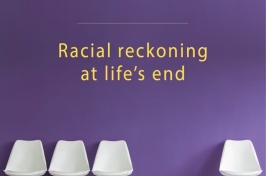The University of New Hampshire inspires innovation and transforms lives in our state, nation and world. More than 16,000 students from all 50 states and 71 countries engage with an award-winning faculty in top-ranked programs in business, engineering, law, health and human services, liberal arts and the sciences across more than 200 programs of study. A Carnegie Classification R1 institution, UNH partners with NASA, NOAA, NSF and NIH, and received $260 million in competitive external funding in FY21 to further explore and define the frontiers of land, sea and space.
UNH Research Finds Impact of Exposure to Gun Violence Needs to Be Addressed with Young Children

DURHAM, N.H.—Young children are less likely to witness gun violence but more likely to feel extreme fear, sadness and upset when they do, according to new research from the Crimes against Children Research Center (CCRC) at the University of New Hampshire.
Researchers found that 41% of youth living in three communities with elevated violence risk reported seeing or hearing indirect gun violence and 32% had experienced it in the past year. Most indirect gun violence exposure involved hearing gunshots in public places while 16% of youth saw gun violence.
Homicide by firearm is among the top 10 leading causes of injury and death for all youth, even those as young as age 1, according to the National Center for Health Statistics & National Vital Statistics System. Although many youths are directly exposed to gun violence, they can also be indirectly exposed by witnessing gun violence or hearing gunshots in their community.
More older (54%) than younger (29%) youth and more youth living in urban (51%) than rural (29%) areas were indirectly exposed to gun violence. Among exposed youth, 50% took protective action to keep themselves safe including hiding somewhere until it was over and going a different way to get somewhere after the exposure. More than half (58%) reported being very or extremely afraid, sad or upset as a result of the violence. In addition, having a lower sense of safety, a history of other types of victimization, other life adversity exposure and higher community disorder were all factors that kept youth from taking protective action.
“Gun violence is a national health issue of heightened concern,” the researchers said. “This study provides new insight into the impact of indirect gun violence exposure on youth and on young children in particular, and the need to be sensitive to community and developmental issues when considering avenues for addressing gun violence prevention and intervention.”
The research, published in the Journal of Interpersonal Violence, was conducted by Kimberly Mitchell and Lisa Jones, research associate professors of psychology at UNH’s CCRC; Heather Turner, professor of sociology at UNH; Cheryl Beseler, an epidemiologist with a focus in statistics; Sherry Hamby, director of the Life Paths Appalachian Research Center in Tennessee; and Roy Wade Jr., an instructor of pediatrics at the University of Pennsylvania. It was funded by a National Institutes of Health (NIH) grant.
Latest News
-
April 15, 2025
-
Research Finds Rural Americans Carry Heavy Burden Accessing Social Security Benefits and InformationMarch 27, 2025
-
March 25, 2025
-
March 17, 2025
-
March 12, 2025













































